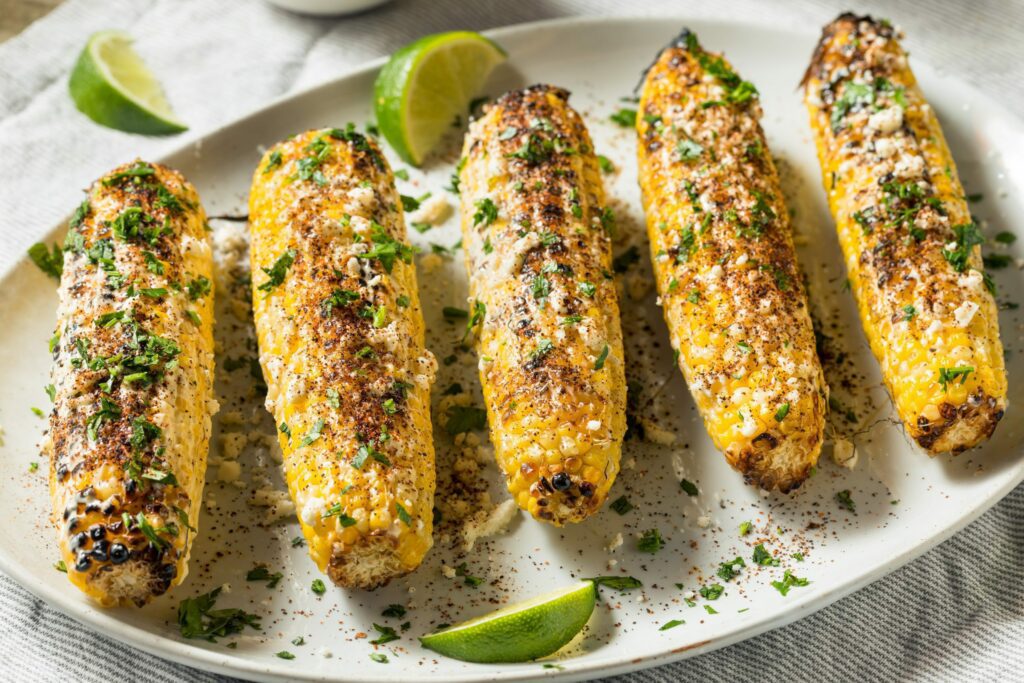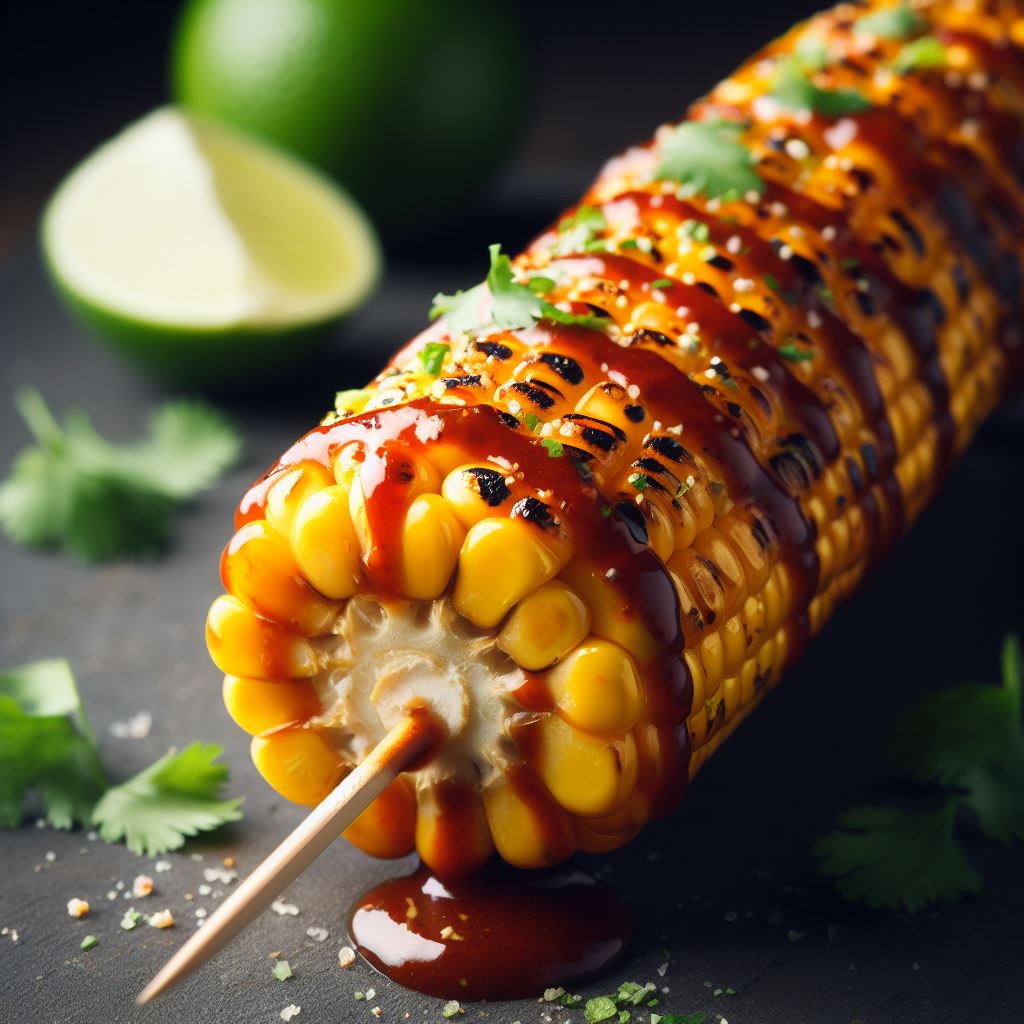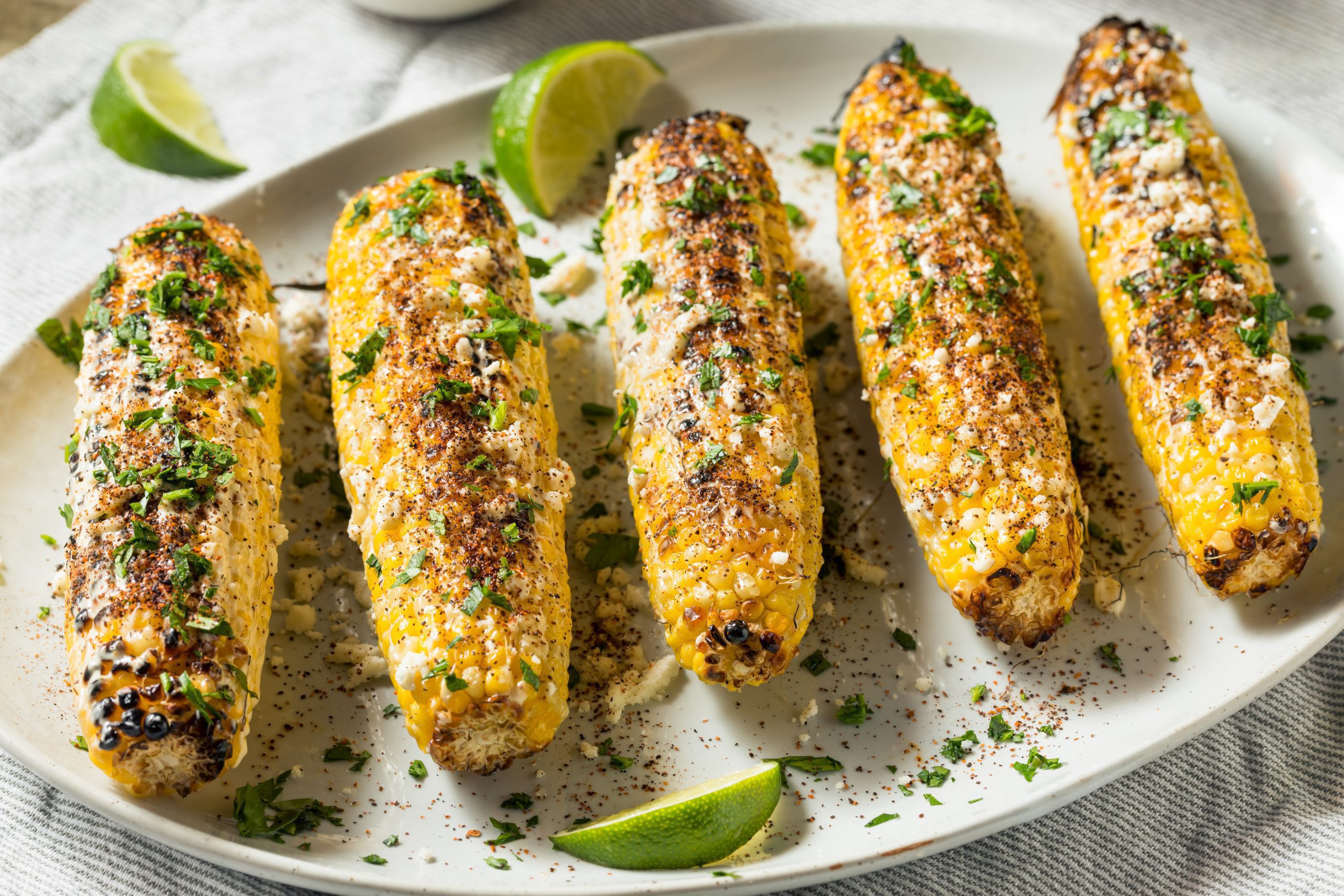How to Make Mexican Street Corn
Growing up in Los Angeles, and travelling to Mexico often I remember one of my fondest memories is the tantalizing aroma of Mexican street corn that would waft through the bustling streets. The mere thought of it transports me back to those vibrant, sunny days when I would eagerly line up at the corner food stall, eagerly waiting for my turn to savor this delightful treat. The sweet corn, perfectly charred, would be slathered with a creamy layer of tangy mayonnaise, sprinkled generously with crumbled cotija cheese, and then drizzled with a squeeze of fresh lime juice. The flavors would blend harmoniously, creating an explosion of taste that was unmatched.
Thank you for reading this post, don't forget to subscribe!
It was a sensory experience that left an indelible mark on my culinary journey. Now, I find solace in recreating that authentic street corn recipe in the comforts of my own kitchen. With a few simple ingredients and a little culinary finesse, I am able to transport myself back to the enchanting streets of Mexico. I carefully select the freshest corn on the cob available, appreciating the inherent sweetness that nature provides.
As the corn grills on the hot stove, I whisk together the creamy mayonnaise, incorporating a hint of smoky chipotle pepper for an extra kick. I crumble the salty cotija cheese, capturing its crumbly texture and distinct flavor. Finally, I squeeze a generous wedge of lime, introducing a burst of citrus that harmonizes all the elements together. As I take my first bite, I am engulfed in nostalgia, feeling the warmth of the Mexican sun on my face and the vibrant energy of the streets. Each succulent kernel of corn bursts with flavor, the creamy mayonnaise clinging to it like a comforting embrace.
The subtle smokiness from the chipotle pepper dances on my palate, while the cotija cheese adds its distinct salty tang. The refreshing squeeze of lime cuts through the richness, invigorating my taste buds and leaving me craving for more. Preparing street corn at home not only allows me to relish the flavors of my childhood but also fosters a connection to my heritage. It serves as a reminder of the vibrant and diverse culinary tapestry that Mexico offers, where every bite tells a story of tradition and culture.
Sharing this recipe with friends and family in LA not only brings us closer but also spreads the joy of Mexican cuisine, allowing others to experience the magic of street corn. So, the next time you find yourself yearning for a taste of Mexico, I encourage you to embark on this culinary adventure and recreate the enchanting street corn in your own kitchen.
Looking for a delicious and easy summer recipe? Look no further than Mexican street corn! This dish is perfect for gatherings with friends or family, and it’s sure to be a hit. In this blog post, we will show you how to make Mexican street corn step-by-step. So, get ready to enjoy the taste of summer!
Ingredients:
- One dozen ears of corn, shucked
- One cup mayonnaise
- One lime, juiced
- Two tablespoons chili powder
- 1/4 cup chopped cilantro
- cotija cheese (optional)
25 minutes to prepare. Serves six people.
Instructions:
01. Preheat the grill to medium-high heat. Grill the corn, turning occasionally until charred on all sides.
02. In a small bowl, combine the mayonnaise and lime juice. Mix well. Spread this mixture over each ear of corn to coat evenly (this can be done with a spoon or by using your hands). Sprinkle generously with chili powder!
03. Serve immediately with a side of tortilla chips for best results.
04. Drink suggestions- queso fresco, or cerveza (beer)
How many carbohydrates are there is Mexican street corn? Each serving has 21.2 grams of carbs (serving size is one ear of corn)
How much cholesterol in Mexican street corn? Each serving is 12.3 mg (heart doctors rejoice!)
There you go a nice simple recipe to add to recipe index to add some good color and fiber to your next meals.

Substitutions in Recipe
Mayonnaise = Greek yogurt
Lime juice – Lemon juice
Chili powder = cayenne powder or any other ground hot pepper
Cilantro = Parsley or Basil
Cotija cheese = sharp chedder or just about any cheese you have.
History Of Corn
What is Mexican street corn name in Spanish? maíz callejero mexicano
Corn is a grain crop that is grown in many parts of the world. It is a key component of the Mexican and American diet. In this article, we will discuss the history and benefits of corn.
Corn was first domesticated by the indigenous people of Mexico over 10,000 years ago. It was one of the first crops to be cultivated in the New World. Corn is an important source of food for humans and livestock, and it is also used to make ethanol fuel.
Corn is a versatile crop that can be grown in a variety of climates. It is drought-tolerant and can withstand hot temperatures. Corn is also a high-yield crop, and it is a major source of food for humans and livestock.
Corn is an important part of the Mexican and American diet and is a key component of many dishes, including tacos, quesadillas, and chili. Corn is also used to make ethanol fuel, which helps reduce our dependence on foreign oil.
In the next section of this blog post, we will discuss some common questions people have when they are learning how to make Mexican street corn. We will also share our top five tips for making this delicious dish at home!
What is Mexican Street Corn?
Mexican street corn is a popular dish that is made with grilled or boiled corn, mayonnaise, chili powder, and lime juice. It is typically served as an appetizer or side dish.
How Do To Make Mexican Corn In A Cup?
The best Mexican street corn recipe is a little different than the typical American ear of corn. It’s made in a cup, and it involves mayonnaise, chili powder, and lime juice. That’s right – you can enjoy this delicious dish without grilling or boiling any corn! You’ll need to start with one dozen ears of corn (you can also use frozen, but it won’t taste quite as good), one cup mayonnaise, two tablespoons chili powder, and one large lime for juicing.
Please read on for instructions on how to make Mexican street corn in a cup!
1) Preheat oven temperature to 350 degrees Fahrenheit. Line up 12 cups on baking sheet that have been sprayed with non-stick cooking spray.
2) Shuck corn and place one piece of corn in each cup. You can also use frozen corn, but it won’t taste as good.
3)Bake for 25 minutes stirring occasionally or until corn is tender and starting to brown on the edges. Serve with lime wedges for squeezing over top if desired!
Mayonnaise mixture:
- In a small bowl, mix together mayonnaise and lime juice until smooth.
- When corn is done baking smear a good coat of mayonnaise mixture.
- Sprinkle chili powder on top of each ear of corn.
–Enjoy!!! Just like they make in the Mexican food trucks and restaurants.
A Guide On How To Buy Corn
There are many different types of corn in the grocery store, and it can be hard to pick out the right one for your recipe. To make things easier for yourself, we’ll go over some key factors that you should keep in mind when choosing which type of corn to purchase.
Buy Corn With. Discount At Amazon, Click Here
First off, let’s talk about what kind of recipes you have planned for the corn; if these include a lot of butter or oil then yellow sweet varieties are best as they contain higher levels of natural sugars which creates a sweeter flavor when heated up with other ingredients.
If however, you plan on using your raw kernels as is then white varieties might be more appropriate since these contain less sugar content which can give them a slightly bitter taste when cooked in buttery sauces or oils.
Another thing you’ll need to consider before purchasing corn is how much time you have to prepare it. For dishes that require a longer cooking time, such as boiling or roasting, the firmer varieties like Silver Queen or Iochief will work better than the softer types like sweet corn.
If you want a dish that can be made quickly, like a salad or salsa, then the softer types will be better.
There are also different colors of corn available on the market and each one has its own unique flavor profile; for example, blue corn is earthier while purple corn is slightly sweeter. If you’re looking to experiment with new flavors then try out some different types!
Lastly, you’ll want to think about how much money you have budgeted for this meal. For example if your recipe calls for two ears of corn but only one type is available at the grocery store then it might be cheaper to buy that particular kind rather than getting both varieties separately. This way there will still be plenty of corn left over for other dishes.
With all these factors in mind, you should be able to pick out the perfect type of corn for your recipe! Happy cooking!

Mexican Street Food
Mexican street food is renowned worldwide for its vibrant flavors, rich cultural history, and diverse culinary traditions. From the colorful streets of Mexico City to the bustling markets of Oaxaca, Mexican street food has become an integral part of the country’s gastronomic identity. At first glance, the chaotic streets might overwhelm visitors with the sheer variety of food stalls lining the sidewalks.
However, this is where the true magic of Mexican street food unfolds. Each stall offers a unique experience, showcasing traditional dishes that have been passed down through generations. One cannot discuss Mexican street food without mentioning the iconic taco. These handheld delights come in countless variations, each more delicious than the last. Whether you opt for the classic al pastor, marinated in a blend of spices and cooked on a vertical spit, or the succulent carnitas, slow-cooked until tender and crispy, the flavors will transport you to the heart of Mexico.
As you wander the streets, tantalizing aromas waft through the air, enticing your taste buds. The sizzling sound of meats hitting the grill is accompanied by the rhythmic chopping of fresh cilantro and the sprinkling of tangy lime juice. The careful attention to detail and the use of vibrant ingredients create a symphony of flavors that burst in your mouth with every bite.
Apart from tacos, other street food favorites include the beloved quesadillas, mouthwatering tamales, and hearty tortas. Each dish showcases the country’s culinary diversity, with regional specialties varying from state to state. For instance, in the Yucatan Peninsula, you’ll find the famous cochinita pibil, a slow-roasted pork dish marinated in achiote paste and sour orange juice, wrapped in a banana leaf.
Moreover, Mexican street food offers a treasure trove of vegetarian and vegan options. From the fiery elotes, grilled corn on the cob slathered in mayonnaise, chili powder, and cheese, to the refreshing agua frescas, fruit-infused beverages that provide respite from the scorching sun, there is something to suit every taste and dietary preference.
One cannot discuss Mexican street food without mentioning its social significance. Street food stalls serve as meeting points where locals and tourists alike gather to share a meal and engage in lively conversations. These vibrant spaces not only satisfy hunger but also foster a sense of community and cultural exchange. While some may shy away from street food due to concerns about hygiene, rest assured that many street vendors take great pride in maintaining high standards of cleanliness. In fact, some of the best meals can be found in the humblest of stalls, where the passion and expertise of the cooks shine through.
In conclusion, Mexican street food is an enchanting culinary experience that encapsulates the soul of the country. Its diverse flavors, rich history, and social significance make it a must-try for any food lover. So, next time you find yourself in Mexico, venture into the vibrant streets, follow the tantalizing scents, and embark on a mouthwatering journey that will undoubtedly leave you craving for more.
Growing Corn In Mexico
Mexico has a rich history when it comes to corn cultivation. The practice dates back thousands of years, with evidence of corn cultivation found in archaeological sites predating the arrival of Europeans in the Americas. Today, corn remains a staple crop and an essential part of Mexican culture and cuisine. In Mexico, corn is grown in various regions with different climates and soil types. The country’s diverse geography allows for the cultivation of different types of corn, each with its unique characteristics and uses.
For instance, the highlands of central Mexico are known for producing white corn, which is commonly used to make tortillas. In contrast, the tropical regions of the country are ideal for the cultivation of yellow corn, used to make other traditional dishes. Corn farming in Mexico involves traditional agricultural methods passed down through generations. Many small-scale farmers still rely on manual labor or simple tools like hoes and machetes. These traditional techniques contribute to the authenticity and distinct flavor of Mexican corn products.
The cultivation process begins with selecting the right seeds. Farmers often save seeds from the previous harvest, ensuring that each generation of corn is well-adapted to the local conditions. This practice preserves the genetic diversity of corn varieties in Mexico, safeguarding against potential crop failures and promoting resilience.
Farmers then prepare the land by plowing and tilling. In some regions, farmers practice the traditional method of milpa, where corn is planted alongside other crops such as beans and squash. This ancient technique promotes biodiversity and helps to maintain soil fertility naturally. Once the land is prepared, farmers plant the corn seeds. They carefully space the seeds to allow enough room for each plant to grow and thrive. Some farmers also incorporate organic fertilizers or compost to provide additional nutrients to the soil.
Throughout the growing season, farmers closely monitor their corn fields, ensuring that the plants receive sufficient water and protection from pests and diseases. In some areas, farmers rely on traditional irrigation methods, while others have adopted more modern techniques, such as drip irrigation, to conserve water and maximize crop yield.
As the corn plants mature, farmers harvest the ears of corn. In traditional farming communities, harvesting often involves a collective effort, with families and neighbors coming together to help each other. This practice fosters a sense of community and strengthens social bonds. After harvesting, the corn is either consumed fresh or dried for later use. Drying corn is a crucial step, as it allows for long-term storage and the production of corn-based products such as masa, a dough used for making tortillas and tamales.
From field to table, the journey of corn in Mexico is deeply intertwined with the country’s heritage and traditions. The cultivation of corn not only sustains livelihoods but also serves as a symbol of cultural identity and connection to the land. Whether enjoyed as a delicious meal or celebrated in festivals, corn remains an integral part of Mexican life.
My disclosure policy states there may contain affiliate links on this page an all income goes to writing more great content for this blog. Lets throw together some corn recipes tonight for supper or game day appetizers!
Try Our Delicious Mexican Cornbread Recipe, Click Here
Mexican Restaurant Queso Recipe Revealed, Click here


